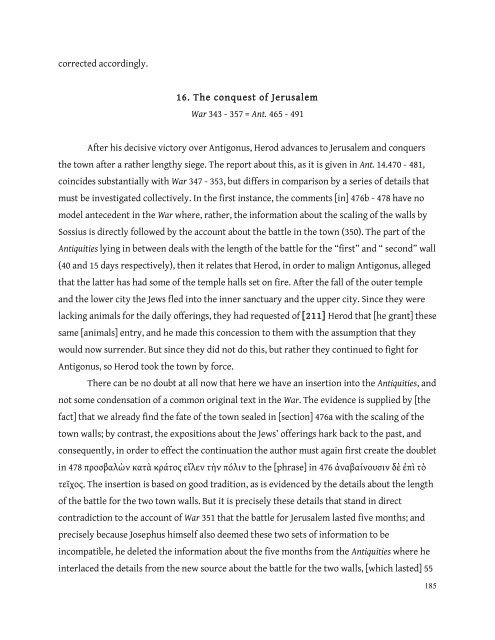The Jewish Historian Flavius Josephus: A Biographical Investigation
The Jewish Historian Flavius Josephus: A Biographical Investigation
The Jewish Historian Flavius Josephus: A Biographical Investigation
You also want an ePaper? Increase the reach of your titles
YUMPU automatically turns print PDFs into web optimized ePapers that Google loves.
corrected accordingly.<br />
16. <strong>The</strong> conquest of Jerusalem<br />
War 343 - 357 = Ant. 465 - 491<br />
After his decisive victory over Antigonus, Herod advances to Jerusalem and conquers<br />
the town after a rather lengthy siege. <strong>The</strong> report about this, as it is given in Ant. 14.470 - 481,<br />
coincides substantially with War 347 - 353, but differs in comparison by a series of details that<br />
must be investigated collectively. In the first instance, the comments [in] 476b - 478 have no<br />
model antecedent in the War where, rather, the information about the scaling of the walls by<br />
Sossius is directly followed by the account about the battle in the town (350). <strong>The</strong> part of the<br />
Antiquities lying in between deals with the length of the battle for the “first” and “ second” wall<br />
(40 and 15 days respectively), then it relates that Herod, in order to malign Antigonus, alleged<br />
that the latter has had some of the temple halls set on fire. After the fall of the outer temple<br />
and the lower city the Jews fled into the inner sanctuary and the upper city. Since they were<br />
lacking animals for the daily offerings, they had requested of [211] Herod that [he grant] these<br />
same [animals] entry, and he made this concession to them with the assumption that they<br />
would now surrender. But since they did not do this, but rather they continued to fight for<br />
Antigonus, so Herod took the town by force.<br />
<strong>The</strong>re can be no doubt at all now that here we have an insertion into the Antiquities, and<br />
not some condensation of a common original text in the War. <strong>The</strong> evidence is supplied by [the<br />
fact] that we already find the fate of the town sealed in [section] 476a with the scaling of the<br />
town walls; by contrast, the expositions about the Jews’ offerings hark back to the past, and<br />
consequently, in order to effect the continuation the author must again first create the doublet<br />
in 478 προσβαλὼν κατὰ κράτος εἴλεν τὴν πόλιν to the [phrase] in 476 ἀναβαίνουσιν δὲ ἐπὶ τὸ<br />
τεῖχος. <strong>The</strong> insertion is based on good tradition, as is evidenced by the details about the length<br />
of the battle for the two town walls. But it is precisely these details that stand in direct<br />
contradiction to the account of War 351 that the battle for Jerusalem lasted five months; and<br />
precisely because <strong>Josephus</strong> himself also deemed these two sets of information to be<br />
incompatible, he deleted the information about the five months from the Antiquities where he<br />
interlaced the details from the new source about the battle for the two walls, [which lasted] 55<br />
185
















